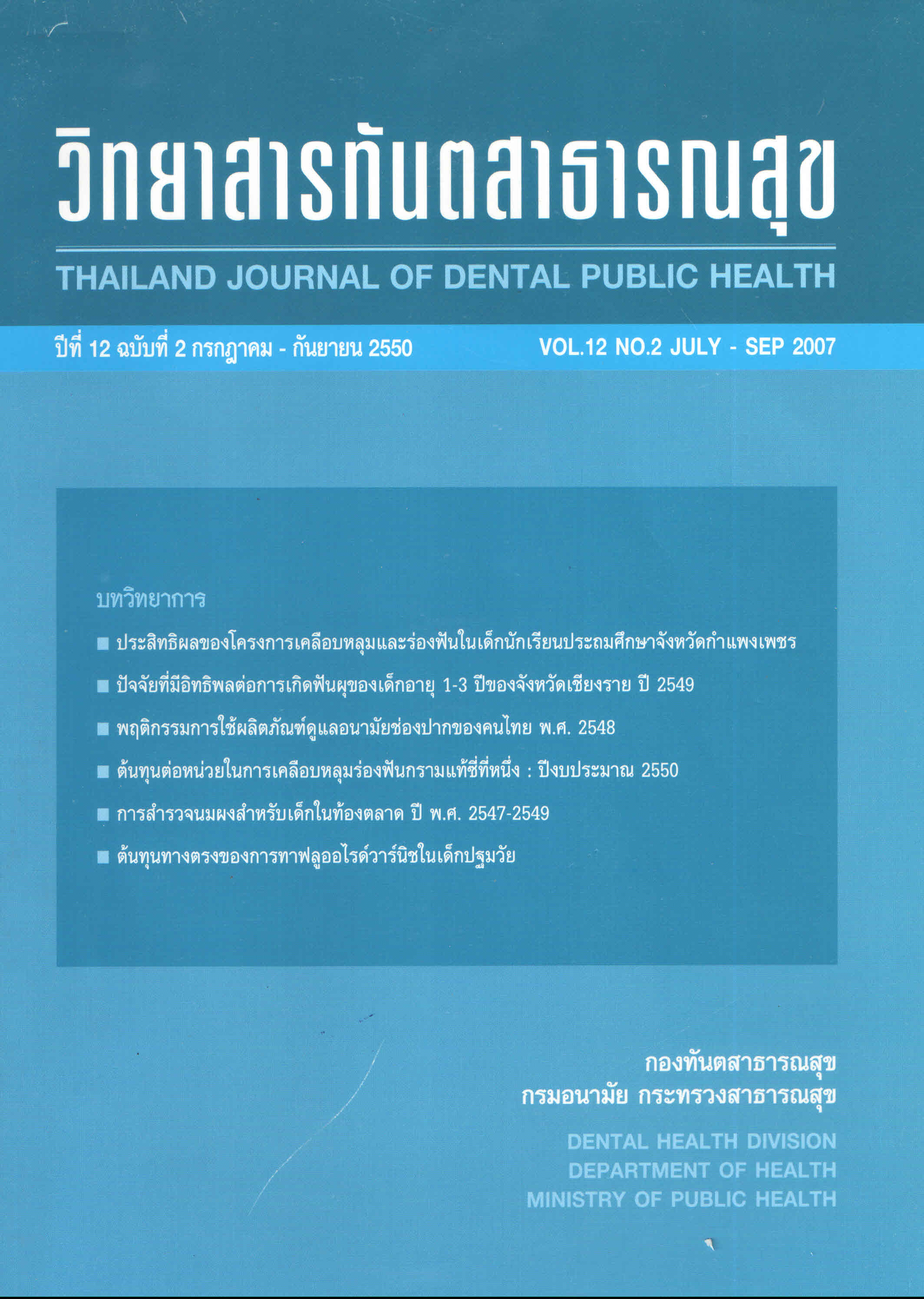Factors related to Dental Caries in Thai children aged 1-3 years, Chiangrai province, 2006.
Main Article Content
Abstract
The purpose of this study was to identify associated risk factors of early childhood caries (ECC) in a sample of Thai children 1-3 year of age. Samples were children who came for vaccinatio at well baby clinics Data were collected by interviewing caregivers who brought their children to well baby clinics for vaccination by 17 MOPH hospitals in Chiangrai province during May - June, 2006. The survey was pinpointed to population demographic, all sorts of food taken in last week, snacks and drinks taken in last 24 hours with their taking reasons and dental caries examination. A number of 170 samples were derived and analysed by Chi-square test and forward stepwise logistic regression statistics. Results revealed that actual caregivers were mothers and family 74.1 %, educated by primary level (45.9%) and earned by income less than 10,000 Bahts per month (60.6%). The prevalence of dental caries among samples was 32.9%. Entire 24 hour snacks and drinks were summed up to 773 items including fruits (15.5%), snacks (24.7%), sugar-free drinks (33.9%) and sugar drinks (25.9%). It was also found that associated risk factors of children's caries experience included oral hygiene, frequent consumption of snacks and drinks and sweetened milk consumption.
Downloads
Article Details
References
2. Casamassimo PS. Relationships between oral and systemic health. Pediatr Clin North Am 2000;47:1149-57.
3. เพ็ญทิพย์ จิตต์จํานงค์ และคณะ รายงานผลการสํารวจสภาวะปราศจากฟันผุของเด็กอายุ 3 ปี พ.ศ. 2547 เอกสารโรเนียว 2547.
4. Edmonson EMS. Food composition and food cariogenicity factors affecting the cariogenic potential of foods. Caries Res 1990;24(Suppl 1):60-71.
5. American Academy of Pediatric Dentistry. Infant oral health. Pediatr Dent 1994; 16:29. 1.
6. ชัยยุทธ ศิริวิบุลกิตติ รายงานผลการวิจัย ความรู้ ทัศนคติและการปฏิบัติของมารดา เกี่ยวกับการดูแลสุขภาพนักเรียนอนุบาลในเขตเทศบาลเมือง จังหวัดลพบุรี, 2536
7. ธนัชพร บุญเจริญ, กัลยา อรุณแก้ว. การศึกษาความชุกของโรคฟันผุในเด็กก่อนวัยเรียน อายุ 1-5 ปี และปัจจัยของมารดาที่มีอิทธิพลต่อ อัตราการเกิดโรคฟันผุของบุตรที่โรงพยาบาล แม่และเด็ก เชียงใหม่ พ.ศ. 2535 ศูนย์ส่งเสริมสุขภาพเขต 10 เชียงใหม่, 2535
8. Ripa LW. Nursing caries:a comprehensive review. Pediatr Dent 1988;10:268-82.
9. Greenwell AL, Johnsen D, Disantis TA, Gerstenmaier J, Limbert N. Longitudinal evaluation of caries pattern from the primary to the mixed dentition. Pediatr Dent 1990;12:278-282.
10. Weinstein P, Domoto P, Koday M, Leroux
B. Results of a promising open trial to prevent baby bottle tooth decay : a fluoride vanish study. ASDC J Dent Child 1994;61: 338-41.
11. สมนึก ชาญด้วยกิจ สุณี วงค์คงคาเทพ ขนิษฐ์ รัตนรังสิมา อังคณา ฤทธิ์อยู่ อิทธิพลของ พฤติกรรมการบริโภคอาหารของเด็กไทยอายุ 6 - 30 เดือนต่อการเกิดโรคฟันผุ. ว. ทันต 2547: 2: 123-136.
12. วิไลลักษณ์ บังเกิดสิงห์ พวงทอง ผู้กฤตยาคามี วิกุล วิสาลเสสถ์ สุรัตน์ มงคลชัยอรัญญา ศรีสุดา ลีละศิธร รายงานเบื้องต้น ปัญหาฟันผุ และพฤติกรรมที่มีผลต่อการเกิดฟันผุในเด็กวัย ก่อนเรียน เฉพาะพื้นที่ 8 หมู่บ้านของอําเภอ กันทรารมย์ จ.ศรีสะเกษ
13. Vachirarojpisan T, Shinada K, Kawaguchi Y, Laungwechakan P, Somkote T, Detsomboonrat P. Early childhood caries in children aged 6-19 months. Community Dent Oral Epidemiol 2004; 32: 1-10
14. วิกุล วิสาลเสสถ์และคณะ บทบาทของมารดาในการดูแลฟันลูกวัย 0-3 ปี กองทันตสาธารณสุข กรมอนามัย, 2535: 19-20.
15. บุบผา ไตรโรจน์ จันทนา อึ้งชูศักดิ์ วิไลลักษณ์ บังเกิดสิงห์ และสุรางค์ เชษฐพฤนท์, การศึกษา สถานการณ์การบริโภคนมของเด็กวัยก่อนเรียน ในศูนย์เด็กเล็ก พ.ศ. 2546. ว.ทันต.สธ 2546 8(1-2): 31-37.
16. อุไรพร จิตต์แจ้ง ประไพศรี ศิริจักรวาล กิตติ สรณเจริญพงศ์ ปิยะดา ประเสริฐสม และผุสดี จันทร์บาง, รายงานการวิจัยเรื่องการศึกษา พฤติกรรมการบริโภคขนมและอาหารว่างของ เด็ก 3-5 ปี พ.ศ.2547. (เอกสารโรเนียว)


